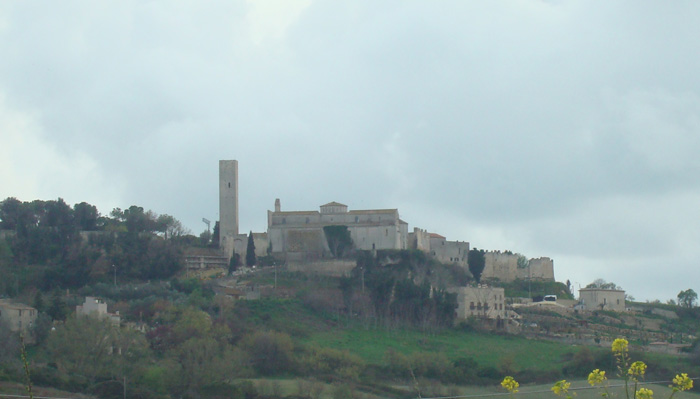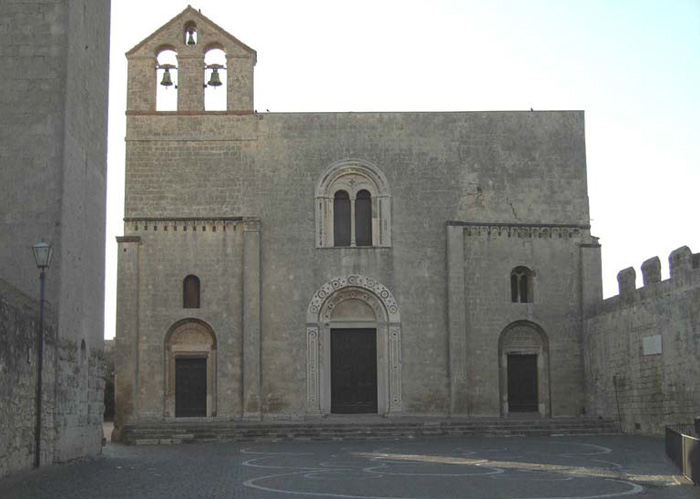| |
|
Chiesa di Santa Maria di Castello (1121-1208), with Lombard and Cosmatesque influences. The façade has a small bell-tower and three entrances. The interior has a nave and two aisles, divided by massive pilasters with palaeo-christian capitals and friezes.
Ancient Tarquinia was one of Eturuia's most important cities. Tarquinia is one of the best places to see Etruscan tombs and it has an excellent archaeological museum.
The Palazzo Vitelleschi has been built around the middle of the 15th century by Giovanni Vitelleschi, born in Tarquinia.
The Etruscan tombs are on a hilltop just outside the main town. About 6000 tombs were dug into the soft volcanic tufa and some were painted inside with colorful frescoes.
The necropolises of Tarquinia and Cerveteri
The two necropolises constitute a unique and exceptional testimony to the ancient Etruscan civilisation.
The cemeteries, replicas of Etruscan town planning schemes, are some of the earliest existing in the region.
The necropolis of Tarquinia, also known as Monterozzi, contains 6,000 graves cut in the rock. It is famous for its 200 painted tombs, the earliest of which date from the 7th century BC. Tarquinia's large-scale wall paintings are exceptional both for their formal qualities and for their content, which reveal aspects of life, death, and religious beliefs of the ancient Etruscans.
Forty-five minutes south of Tarquinia lies Cerveteri, another major Etruscan city. The tombs here are located in a kind of park.
The necropolis near Cerveteri, known as Banditaccia, contains thousands of tombs organized in a city-like plan, with streets, small squares and neighbourhoods.
The graves here are still covered under mounds (tumuli), which are overgrown with grass and shrubs.
Norchia, inland from Tarquinia, has tombs carved out of rocks on the large cliffs.
Sutri, also inland, has an Etruscan ampitheater.
Tarquinia Monterozzi necropolis, area of Calvario
|
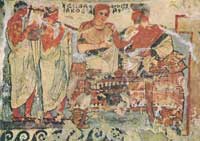 |
|
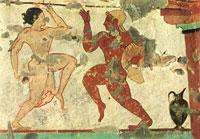 |
|
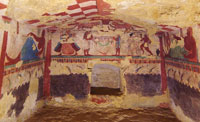 |
| |
|
|
|
|
| |
|
|
|
|
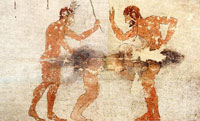 |
|
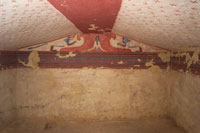 |
|
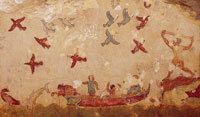 |
| |
|
|
|
|
| |
|
|
|
|
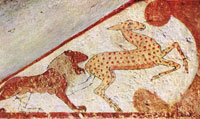 |
|
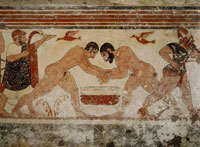 |
|
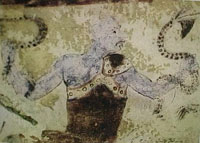 |
|
|
|
|
|
The archaeology of Tarquinia has been at the forefront of Etruscan studies since the early days of antiquarian scholarship and is renowned for its unique painted tombs and vast cemeteries, and attracted eminent writers and poets, among them Stendhal, D.H. Lawrence, Aldous Huxley and Malaparte.
Among the famous writers drawn to Tarquinia's enigmatic Etruscan past, its legends, and cultural heritage were Stendhal, D.H. Lawrence, Aldous Huxley and Malaparte.
Henri Bleyle Stendhal, the great 19th-century French novelist who penned The Red and the Black, was for a time a diplomat in Rome. He became enchanted with Tarquinia, then known as Corneto, and authored a long article about its recently discovered Etruscan tombs.
In early April 1927 D.H. Lawrence embarked on what was to be his last extended walking tour. Accompanied by his friend Earl Brewster, he visited the major sites associated with the Etruscans, from Volterra in the north of Tuscany to Tarquinia.
|
The Tomb of the Leopards is a charming, cosy little room, and the paintings on the walls have not been so very much damaged. All the tombs are ruined to some degree by weather and vulgar vandalism, having been left and neglected like common holes, when they had. been broken open again and rifled to the last gasp.
But still the paintings are fresh and alive: the ochre-reds and blacks and blues and blue-greens are curiously alive and har-monious on the creamy yellow walls. Most of the tomb walls have had a thin coat of stucco, but it is of the same paste as the living rock,. which is fine and yellow, and weathers to a lovely., creamy gold, a beautiful colour for a background.
The walls, of this little tomb are a dance of real delight. The room seems inhabited still by Etruscans of the sixth century before Christ, a vivid, life-accepting people, who must have lived with real fullness. On come the dancers and the music-players, moving in a broad frieze towards the front wall of the tomb, the wall facing us as we enter from the dark stairs, and where the banquet is going on in all its glory. Above the banquet, in the gable angle, are the two spotted leopards, heraldically facing each other across a little tree. And the ceiling of rock has chequered slopes of red and black and yellow and blue squares, with a roof-beam. painted, with coloured, circles, dark red and blue and yellow. So that all is colour, and we do not seem to be underground at all, but in some gay chamber of the past.
The dancers on the right wall move with a strange, powerful alertness onwards. The men are dressed only in a loose coloured scarf, or in the gay handsome chiamys draped as a mantle. The subulo plays the double flute the Etruscans loved so much, touching the stops with big, exaggerated hands, the man behind him touches the seven-stringed lyre, the man in front turns round and signals with his left hand, holding a big wine-bowl in his right. And so they move on, on their long; sandalled feet, past the little berried olive trees, swiftly going with their limbs full of life, full of life to the tips.
This sense of vigorous, strong-bodied liveliness is charac-teristic of the Etruscans, and is somehow beyond art. You cannot think of art, but only of life itself, as if this were the very life of the Etruscans, dancing in their coloured wraps with massive yet exuberant naked limbs, ruddy from the air and the sea-light, dancing and fluting along through the olive trees, out in the fresh day.
The end wall has a splendid banqueting scene. The feasters recline upon a checked or tartan couch-cover, on the banquet-ing couch, and in the open air, for they have little trees behind them. The six feasters are bold and full of life like the dancers, but they are strong, they keep their life so beautifully and richly inside themselves, theyare not loose, they don't lose themselves even in their wild moments. They lie in pairs, man and woman, reclining equally on the couch, curiously friendly. The two end women are called hetaerae, courtesans;. chiefly because they have yellow hair, which seems to have: been a favourite feature in a woman of pleasure. The men are dark and ruddy,and naked to the waist. The women, sketched on the creamy rock, are fair, and wear thin gowns, with rich mantles round their hips. . They have a certain free bold look, and perhaps really are courtesans.
The man at the end is holding up, between thumb and forefinger, an egg, showing it to the yellow-haired woman who reclines next to him, she who is putting out her left hand as if to touch his breast. He, in his right hand, holds a large wine-dish, for the revel.
The next couple, man and fair-haired woman, are looking round and making the salute with the right hand curved over, in the usual Etruscan gesture It seems as if they too are saluting the mysterious egg held up by the man at the end who is, no doubt, the man who has died, and whose feast is being celebrated. But. in front of the second couple a: naked slave with a chaplet on his head is brandishing an empty winc jug, as if to say he is fetching more wine. Another slave farther down is holding out a curious thing like a little axe, or fan. The last two feasters are rather damaged. One of them is holding up a garland to the other but not putting it over his head as they still put a garland over your head in India, to honour you.
Above the banqueters, in the gable angle, the two great. spotted male leopards hang out their tongues and face each other heraldically, lifting a paw, on either side of a little tree.. They are the leopards or panthers of the underworld Bacchus, guarding the exits and the entrances of the passion of life.
There is a. mystery and a portentousness in the simple scenes which go deeper than commonplace life.. It seems all so gay and light Yet there is a certain weight or depth of significance that goes beyond aesthetic beauty.
[D.H. Lawrence in Tarquinia, The Tomb of the Leopards | www.stanford.edu]
|
|
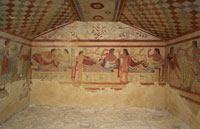
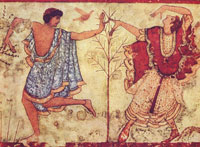
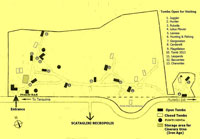
|
|
|
|
|
|
|
Tarquinia | The Necropolises of Tarquinia and Cerveteri
Tarquinia | The Tomba delle Leonesse, at Tarquinia (The Tomb of the Lionesses) |
|
| 
Located on the outskirts of Castiglioncello Bandini, Podere Santa Pia offers the quiet tranquility of a private retreat, with numerous attractions and gorgeous small hillside villages, beautiful beaches only a short drive away.
Explore the medieval hillside villages on your way to Tarquinia, marvel at settlements that date back to Etruscan times, try some Morellino di Scansano Scansano, where the refined beauty of the squares and churches blends perfectly with the ancient traditions of its wines.
Hidden secrets in Tuscany | Holiday home Podere Santa Pia
|
 |
Podere Santa Pia is situated in a hilly and unspoilt land, about one hour drive from Siena, surrounded by woods, olive groves and vineyards, where the Monte Amiata hills slope to the Maremma plain and the sea can be seen on the horizon.
|
|
Enlarge map |
The Regional Natural Reserve Selva del Lamone is in the area of the municipality of Farnese at the border between Lazio and Tuscany. It is a truly luxuriant park in which, among wild flowers, mushrooms, squirrels and buzzards, we can enjoy an excursion along the paths and rest in the areas equipped with facilities. |
|
|
